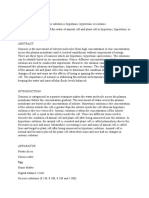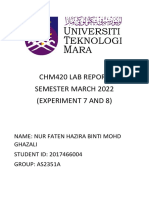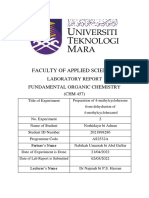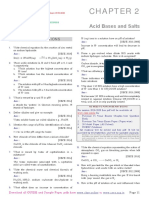Experiment 2 CHM 420
Experiment 2 CHM 420
Uploaded by
bellaaminCopyright:
Available Formats
Experiment 2 CHM 420
Experiment 2 CHM 420
Uploaded by
bellaaminOriginal Description:
Original Title
Copyright
Available Formats
Share this document
Did you find this document useful?
Is this content inappropriate?
Copyright:
Available Formats
Experiment 2 CHM 420
Experiment 2 CHM 420
Uploaded by
bellaaminCopyright:
Available Formats
SUBJECT CODE : CHM 420
EXPERIMENT : 2
TOPIC : WATER OF HYDRATION
DATE : 03/10/2014
NAME : NABILAH BINTI AMINUDDIN
MATRIC NO : 2014805292
I/C NO : 950320145006
GROUP : AS2301M1
LECTURER NAME : DR. ZURAIDA KHUSAIMI
EXPERIMENT 2
WATER OF HYDRATION
OBJECTIVE
To determine the percentage of water in an unknown hydrate qualitatively and quantitatively.
THEORY
In this experiment, the amount of water in the hydrated compound will determined qualitative
and quantatively. In the qualitative part, the behaviour of a hydrate will be observed when the
sample is heated. Meanwhile, in the quantitative part, amount of water driven off can be
determined by heating the sample to constant weight. From, the amount of mass lost, the
percebtage of water in the sample can be determined. This information will be used to
calculate the formula of the hydrate.
CHEMICALS AND APPARATUS
Finely ground copper (II) sulphate pentahydrate Analytical balance
CuS
. 5
O Crucible and cover
Unknown hydrated compounds: Clay triangle
NiC
Trippod stand
Bunsen burner
Tile
Test tube
METHODOLOGY
A. Qualitative determination of water.
1. A clean and dry test tube is obtained and the test tube is held with a clamp with its
mouth is 15-20 degrees above the horizontal. The mouth of the test tube is pointed
away from people.
2. A scoop of copper (II) sulphate pentahydrate is placed in the test tube. The bottom
of the test tube is heat gently to avoid spattering. Changes is observed and
recorded in DATASHEET 2.
3. The test tube and its content is allowed to cool to room temperature.
4. A few drops of water is added into the test tube. Observation is recorded.
B. Quantitative determination of water in a hydrate.
1. The name of the salt that is analyze is recorded.
2. Tap water is used to clean and distilled water is used to rinse a crucible and a
cover. The crucible and cover is placed on the clay triangle. The cover is slightly
opened to allow moisture to escape when the crucible is heated. The crucible and
cover is heated using a bunsen burner for five minutes. Then, the crucible is
allowed to cool to room temperature and its mass is determined. Touching the
crucible or cover with hand is avoided because the moisture from skin will add to
the crucible weight. The same balanced is used for the successive weighing of the
sample.
3. Between 1.000 g 1.500 g of the hydrated compound is placed into a weighed
crucible. The crucible and the content is covered and weighed. The cover is
adjusted so that it is slightly ajar. To avoid spattering, it is gently heated and the
intensity of the flame is increased after five minutes and for about five minutes
heat to redness.
4. The crucible is closed and cooling is allowed for five minutes after heating and the
mass is determined. The heating and weighing is repeated until the results of two
successive weighings agree to within 0.05g. this will ensure thatthat all the water
is completely driven out of the compound.
DATA / RESULLT
A. Qualitative determination of water.
Before heating During heating After heating
Colour of copper (II)
sulphate pentahydrate
Blue Light blue White
Describe the
appearance
Solid Solid Solid
A few drops of water
was added
White to blue
B. Quantitative determination of water in a hydrate.
Sample No: NiC
(Nickle)
1. Mass of crucible + cover = 72.1691g
2. Mass of crucible + cover + sample = 73.2600g
3. Mass of crucible + cover + sample = 72.7230g
(after 1
st
heating)
4. Mass of crucible + cover + sample = 72.6899g
(after 2
nd
heating)
5. Mass of original sample = 1.0909g
6. Total mass loss by sample after heating = 0.5701g
7. Percentage water in sample = 52.26%
CALCULATIONS
5. 73.2600g - 72.1691g = 1.0909g
6. 73.2600g - 72.6899g = 0.5701g
QUESTION
1.
+ heat
(anyhydrous)+ 5
2. Percentage of water in sample :
Mass of hydrated (
) = 73.2600g
Mass of dry compound (an hydrate)
= 1.0909g
Mass of
= 73.2600g - 72.6899g
= 0.5701g
Percentage of
100 %
=
100 %
= 52.26%
3. Formula of hydrate
Molar mass (g/mole) 58.71 + 2 (35.45)
= 129.61
2(1.00) +16.00
= 18.00
No of mole
= 8.4168
mole
= 31.67
mole
Moles of water per mole nickel (II) chloride :
= 4
DISCUSSION
For part A (Qualitative determination of water) the colour of copper (II)
sulphate pentahydrate is blue solid before heating. The blue colour indicates that copper (II)
sulphate is hydrated (attached to water molecule). Next, during heating, the colour of copper
(II) sulphate pentahydrate turn to light blue solid. This show that the copper (II) sulphate is
being hydrated. In addition, after heating, the colour of copper (II) sulphate turns to white
solid which means copper (II) sulphate is completely hydrated. When a few drop of water
was added to white solid copper (II) sulphate the solid turns colour from white to blue. This is
because solid copper (II) sulphate is hydrated once more.
For part B (Quantitative determination of water in a hydrate) the sample given is
NiC
. The compound was weighed and heated and this process is repeated until all the
water is completely driven out of the compound. The reason to this is that we want to know
the mass of water in the compound by comparing the mass of the compound before and after
heating. When the mass of water is known, we can determined the percentage of water in the
compound or sample given. Thus, the percentage of water obtained is 52.26%.
There are several errors done when conducting the experiment. Some of the error are
touching the the crucible and its cover with bare hands. This will add moisture to the crucible
and cover. Next, the crucible containing compounds are not completely cooled down when
weighed. This will affect the mass of the compound as the mass of the compound is not
accurate when it was taken during the crucible is hot. Moreover, when heating copper (II)
sulphate pentahydrate, the test tube is set up as the test tube mouth is in the way of there is
people. This will hurt people who are in front of the test tube mouth when the experiment is
conducted.
There are precaution steps that need to be taken so that errors can be avoided when
experiment is conducted. Wear gloves when you want to touch the crucible or its cover. Next,
wait until the crucible is completely cooled down before weighing it. In addition, set up the
apparatus as the test tube is slightly slanted and its mouth is pointed away from people.
CONCLUSION
The colour of copper (II) sulphate pentahydrate turns from blue to white when it is
heated.The percentage of water in NiC
is 0.78%.
REFFERENCE
Exploring Chemistry Laboratory Experiments for General Chemistry, Sharipah Ruzaini Syed
Aris, Kamariah Muda, Nesamalar Kantasamy,2010,University Publication Cetre (UPENA).
Chemistry 11
th
edition,Raymond Chang, Kenneth A. Goldsby,2014,Mc Graw Hill Education
Oxford Dictionary of Chemistry sixth edition ,John Daintith,2008,Oxford University Press
You might also like
- Lab Report Physics Experiment 1 MeasurementDocument1 pageLab Report Physics Experiment 1 MeasurementAnas Kamal0% (1)
- 9 FtestDocument4 pages9 Ftest박찬우100% (3)
- Lab Bio462 - Experiment 6Document4 pagesLab Bio462 - Experiment 6BalqishNo ratings yet
- Lab Report 1Document10 pagesLab Report 1sheril nur hazianiNo ratings yet
- Bio 400 Lab 5 1Document3 pagesBio 400 Lab 5 1Aqilah AzmanNo ratings yet
- Experiment 2: Water of HydrationDocument10 pagesExperiment 2: Water of HydrationNur Faizatul Atiqah0% (1)
- Lab CHM 420 Exp 2Document4 pagesLab CHM 420 Exp 2nana izzNo ratings yet
- Lab Report CHM420Document10 pagesLab Report CHM420Hani Nadh100% (1)
- Chm421-Experiment 3 - Neutralization Capacity of CommercialDocument9 pagesChm421-Experiment 3 - Neutralization Capacity of Commercialnipale hiNo ratings yet
- Preparation of 4-Methylcyclohexene: BackgroundDocument4 pagesPreparation of 4-Methylcyclohexene: BackgroundVanila AisNo ratings yet
- Chm421-Experiment 8 - Determination of Fe in A Ferum Solution by Gravimetric AnalysisDocument7 pagesChm421-Experiment 8 - Determination of Fe in A Ferum Solution by Gravimetric Analysisnipale hiNo ratings yet
- Lab CHM 457 Exp 2Document10 pagesLab CHM 457 Exp 2JohanNo ratings yet
- Lab Report Exp 2 chm457Document4 pagesLab Report Exp 2 chm457pufff witchesNo ratings yet
- EXP 2 NikDocument6 pagesEXP 2 NikNurul AtikahNo ratings yet
- Experiment 1: Calibration of A Volumetric FlaskDocument5 pagesExperiment 1: Calibration of A Volumetric FlaskNur Faizatul AtiqahNo ratings yet
- Experiment 2 CHM 457Document8 pagesExperiment 2 CHM 457Amirah NajihahNo ratings yet
- chm432 - 4Document2 pageschm432 - 4Nur AthirahNo ratings yet
- Experiment 5 Chemical EquilibriumDocument15 pagesExperiment 5 Chemical EquilibriumSiti Khadijah Binti Abu SaamahNo ratings yet
- Chm420 Lab Report Semester March 2022 (Experiment 7 and 8)Document17 pagesChm420 Lab Report Semester March 2022 (Experiment 7 and 8)faten haziraNo ratings yet
- Exp 1 Chm510Document11 pagesExp 1 Chm510Nur Nadia Syahira100% (1)
- CHM 432 Physical ChemistryDocument5 pagesCHM 432 Physical Chemistryaqielah shaifulNo ratings yet
- Anal Chem Exp 10Document6 pagesAnal Chem Exp 10Anas Kamal67% (3)
- CHM 421 Analytical Chemistry Experiment 1: Calibration of A Volumetric FlaskDocument10 pagesCHM 421 Analytical Chemistry Experiment 1: Calibration of A Volumetric FlaskIntan SapuraNo ratings yet
- Experiment 2 - Analysis of An Unknown Vinegar SampleDocument8 pagesExperiment 2 - Analysis of An Unknown Vinegar SampleHanis Ridzuan100% (1)
- Chm557 Exp2Document4 pagesChm557 Exp2Rap DutaNo ratings yet
- Experiment 1 CHM421Document2 pagesExperiment 1 CHM421aremyrah AzlanNo ratings yet
- CHM 674 Exp 3Document10 pagesCHM 674 Exp 3nabilah hilmiNo ratings yet
- CHM 477 Experiment 3 4 5 PDFDocument10 pagesCHM 477 Experiment 3 4 5 PDFAhmad ZakwanNo ratings yet
- Individual Assignment CHM561Document4 pagesIndividual Assignment CHM561Ahmad ZakwanNo ratings yet
- Lab Report EXP.5 CHM457 Fund. Organic ChemistryDocument6 pagesLab Report EXP.5 CHM457 Fund. Organic ChemistryHusnul HakimNo ratings yet
- Experiment 3thermodynamic Functions and Solubility Product of Barium NitrateDocument9 pagesExperiment 3thermodynamic Functions and Solubility Product of Barium NitrateMay LeeNo ratings yet
- CHM 510Document6 pagesCHM 510aiqalNo ratings yet
- Lab Report chm457 Exp 3Document3 pagesLab Report chm457 Exp 3pufff witchesNo ratings yet
- Experiment 3 CHM 432Document7 pagesExperiment 3 CHM 432Amirah NajihahNo ratings yet
- Experiment 4 & 5Document10 pagesExperiment 4 & 5Mhi Ismail0% (1)
- CHM 421 - Exp10Document4 pagesCHM 421 - Exp10AMIRAH ISHAMI ISHAKNo ratings yet
- General Chemistry (Chm420) : Laboratory ReportDocument6 pagesGeneral Chemistry (Chm420) : Laboratory ReportNajmi NasirNo ratings yet
- chm421 Exp 3Document8 pageschm421 Exp 3Irfan Azahar100% (1)
- Lab Report Exp 3 CHM 524 (Physical Chemistry)Document18 pagesLab Report Exp 3 CHM 524 (Physical Chemistry)NUJMATUL HUDA AHARUL HADAFINo ratings yet
- Title: Preparation of 4-MethylcyclohexeneDocument7 pagesTitle: Preparation of 4-MethylcyclohexeneNur AthirahNo ratings yet
- Lab Report SPMEDocument8 pagesLab Report SPMEAyish MataNo ratings yet
- CHM 420 Lab 5Document9 pagesCHM 420 Lab 5IQBAL SYARIFF SAIFUL RIZALNo ratings yet
- Experiment 4 Stochiometry and Theoretical Yield CHM 420Document7 pagesExperiment 4 Stochiometry and Theoretical Yield CHM 420najwa nabilaNo ratings yet
- Lab Report 2 CELLDocument6 pagesLab Report 2 CELLNur Arina Dayana33% (3)
- chm474 (Exp6)Document16 pageschm474 (Exp6)farah100% (1)
- Exp 6Document11 pagesExp 6Muzak MuzakkirNo ratings yet
- Chm421-Experiment 5 - Distillation and Hardness of WaterDocument11 pagesChm421-Experiment 5 - Distillation and Hardness of Waternipale hiNo ratings yet
- Experiment 6 Acid and Bases CHM 420Document9 pagesExperiment 6 Acid and Bases CHM 420najwa nabila100% (1)
- Spectrochemical Method of Analysis (CHM 580) EXPERIMENT 1:qualitative Analysis of Aspirin Phenacetin Caffeine and Sample Using FTIR and NMRDocument9 pagesSpectrochemical Method of Analysis (CHM 580) EXPERIMENT 1:qualitative Analysis of Aspirin Phenacetin Caffeine and Sample Using FTIR and NMRbatrisyia hazirahNo ratings yet
- Experiment 7 Chlorpyrifos chm510Document6 pagesExperiment 7 Chlorpyrifos chm510Amar SafwanNo ratings yet
- SpectrosDocument2 pagesSpectrosUmmu UmairahNo ratings yet
- Experiment 6: Reactions of AminesDocument8 pagesExperiment 6: Reactions of AminesYul100% (1)
- Laboratory Report CHM 457 Organic Chemistry: Universiti Teknologi Mara, Cawangan Perlis Kampus ArauDocument4 pagesLaboratory Report CHM 457 Organic Chemistry: Universiti Teknologi Mara, Cawangan Perlis Kampus ArauNasuha AriffinNo ratings yet
- Soduim Borohydride Reduction of CyclohexanoneDocument10 pagesSoduim Borohydride Reduction of CyclohexanoneAlohaaSwezzNo ratings yet
- CHM 421 Analytical Chemistry Experiment 2: Analysis of An Unknown Vinegar SampleDocument14 pagesCHM 421 Analytical Chemistry Experiment 2: Analysis of An Unknown Vinegar SampleIntan SapuraNo ratings yet
- Preparation of 4-Methylcyclohexene From Dehydration of 4-MethylcyclohexanolDocument8 pagesPreparation of 4-Methylcyclohexene From Dehydration of 4-MethylcyclohexanolHidayu AdnanNo ratings yet
- Experiment 5 (CHM421)Document9 pagesExperiment 5 (CHM421)Najmi NasirNo ratings yet
- CMT610 Eksp2Document21 pagesCMT610 Eksp2syahidnovovic4No ratings yet
- Lab Report 2.0Document6 pagesLab Report 2.0Husna Insyirah Bt SamadNo ratings yet
- Chem Report (Exp. 2)Document6 pagesChem Report (Exp. 2)dina_qasdinaNo ratings yet
- Exp 2 Lab ReportDocument9 pagesExp 2 Lab ReportDanish HakimNo ratings yet
- Scheme of Work STA408 (MARCH 2014)Document4 pagesScheme of Work STA408 (MARCH 2014)bellaaminNo ratings yet
- Experiment4 CHM 420Document4 pagesExperiment4 CHM 420bellaamin75% (4)
- Experiment 3 CHM 420Document8 pagesExperiment 3 CHM 420bellaamin100% (2)
- Experiment 1 CHM 420Document6 pagesExperiment 1 CHM 420bellaamin100% (1)
- ExportDocument186 pagesExporting_madeNo ratings yet
- USP Monographs Reagents - Test Solutions (TS)Document19 pagesUSP Monographs Reagents - Test Solutions (TS)Jane FrankNo ratings yet
- 1.1 Empirical Formula of Hydrated Copper (II) Sulfate CrystalsDocument4 pages1.1 Empirical Formula of Hydrated Copper (II) Sulfate CrystalslaboranNo ratings yet
- Water of CrystallisationDocument3 pagesWater of CrystallisationKevin RenNo ratings yet
- Cbjesccq 02Document12 pagesCbjesccq 02Sagar MittalNo ratings yet
- ASTM D2794.tzep1589Document3 pagesASTM D2794.tzep1589Kevin XuNo ratings yet
- ErythritolDocument49 pagesErythritolAura Paige Montecastro-RevillaNo ratings yet
- Reversible Reactions (Multiple Choice) QPDocument6 pagesReversible Reactions (Multiple Choice) QPJennifer LohNo ratings yet
- Informe Lab 8 KJHGJDFDocument3 pagesInforme Lab 8 KJHGJDFAtrapa SueñosNo ratings yet
- Ch-6 Q AnsDocument4 pagesCh-6 Q AnshhhNo ratings yet
- CH16ADocument11 pagesCH16AmiracledoraemonNo ratings yet
- Practical 1aDocument6 pagesPractical 1aHoe Lam WanNo ratings yet
- Chemical FormulaeDocument58 pagesChemical FormulaeMuhammad Sheeraz FarooqNo ratings yet
- 9701/21/M/J/20 © Ucles 2020Document10 pages9701/21/M/J/20 © Ucles 2020Fire stormNo ratings yet
- Fix Jurnal p2 SsaDocument11 pagesFix Jurnal p2 SsaKayla Audynia RimadantiNo ratings yet
- Honors Chemistry WKSHT Solution Stoichiometry With Some ANSWERSDocument5 pagesHonors Chemistry WKSHT Solution Stoichiometry With Some ANSWERSAlbert LinNo ratings yet
- 1.5 Water and HydrogenDocument16 pages1.5 Water and Hydrogenjosephngatho454No ratings yet
- Copper (II) Sulfate and Iron Nail Experiment: Arellano University Juan Sumulong Campus Legarda Street, Sampaloc, ManilaDocument4 pagesCopper (II) Sulfate and Iron Nail Experiment: Arellano University Juan Sumulong Campus Legarda Street, Sampaloc, ManilaGEM RakuenNo ratings yet
- Copper Sulfate FlyerDocument2 pagesCopper Sulfate FlyerRAJESH KUNANo ratings yet
- EXE 6 - Group 5 - Phar 1-3 HazeDocument34 pagesEXE 6 - Group 5 - Phar 1-3 HazeEvery MuanNo ratings yet
- Chemistry Practicals First Years 87-3 PDFDocument63 pagesChemistry Practicals First Years 87-3 PDFoscarNo ratings yet
- Cambridge Ordinary Level: Cambridge Assessment International EducationDocument20 pagesCambridge Ordinary Level: Cambridge Assessment International EducationJack KowmanNo ratings yet
- PS - 217-2017Document19 pagesPS - 217-2017Sofia AlviNo ratings yet
- Assign - 6 - Chemical Formulae, Equations, Calculations 1 QPDocument2 pagesAssign - 6 - Chemical Formulae, Equations, Calculations 1 QPDiya JNo ratings yet
- June 2022 Question Paper 61Document20 pagesJune 2022 Question Paper 61evenbetterbetterNo ratings yet
- Technical Data Sheet: Kjeldigester K-446 / K-449Document7 pagesTechnical Data Sheet: Kjeldigester K-446 / K-449Septyani SofatinNo ratings yet
- Extension Folder No-67-Arecanut Fruit RotDocument2 pagesExtension Folder No-67-Arecanut Fruit RotAsh1ScribdNo ratings yet
- CH 11 Notes CompleteDocument55 pagesCH 11 Notes CompleteeherrerahghsNo ratings yet
- Amster Pharmacrit-Product-List 2023 (Softgels)Document19 pagesAmster Pharmacrit-Product-List 2023 (Softgels)S K ChughNo ratings yet





























































































